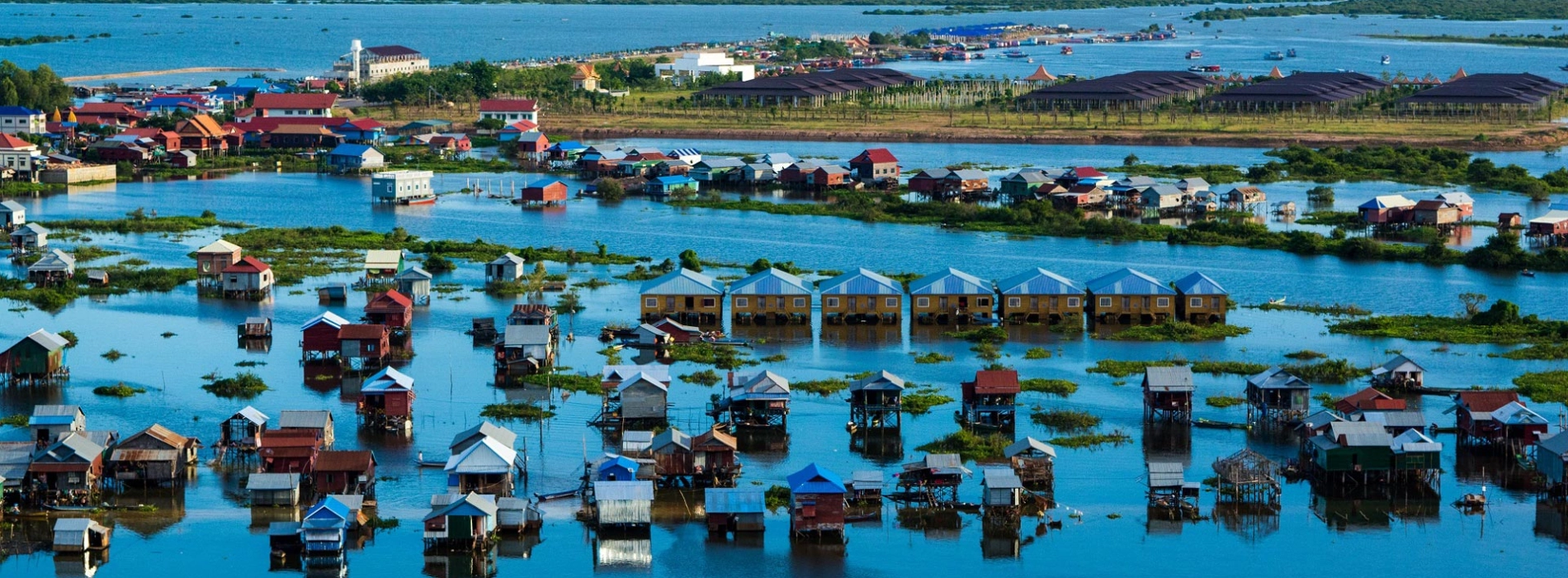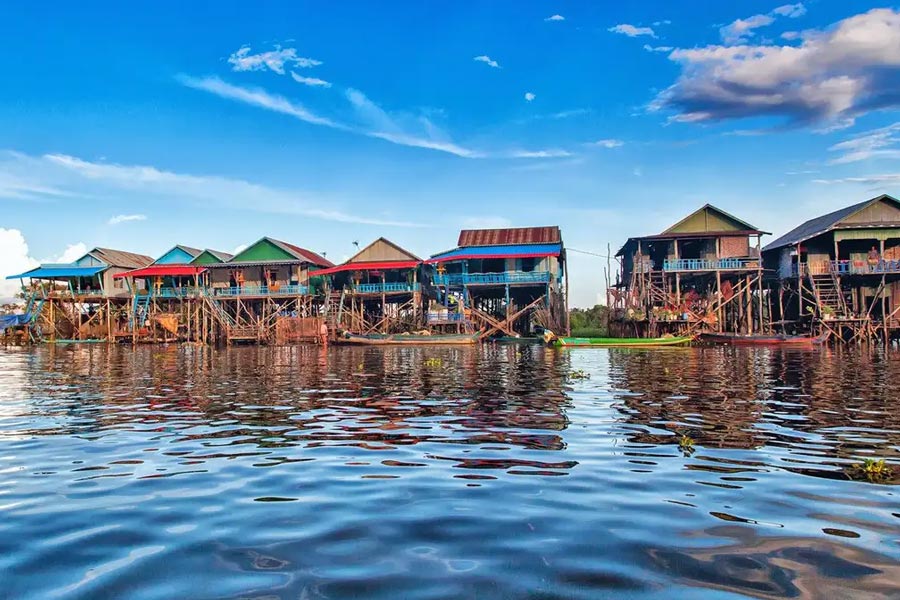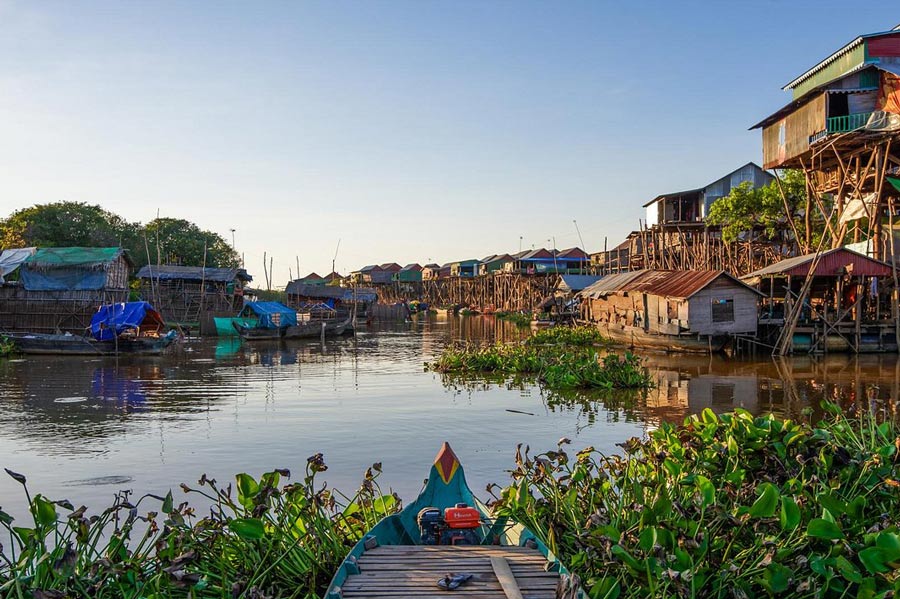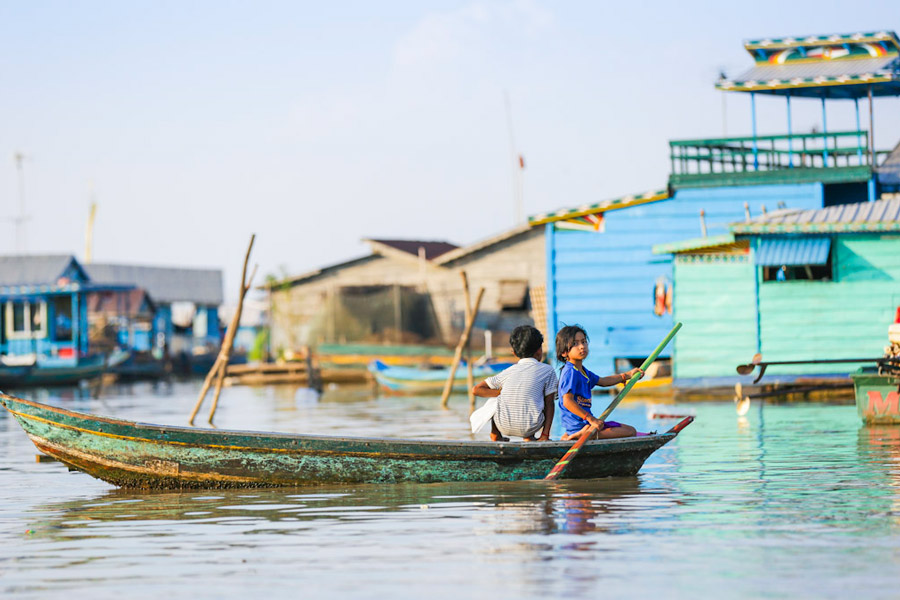Floating Villages on Tonle Sap Lake

The floating villages of Tonle Sap in Cambodia offer a unique glimpse into life on the water. Built on stilts or floating platforms, these communities adapt to seasonal water changes. Boat tours let visitors enjoy the scenery, learn about local traditions, and experience the resilience and culture of the villagers.
The floating villages around Tonle Sap Lake in Cambodia have a long history shaped by the lake’s seasonal water changes. Generations of communities have relied on fishing for livelihood, building stilted or floating houses to adapt to rising and falling waters. These villages developed unique cultural practices and strong social bonds. While tourism brings economic benefits, it also challenges traditional lifestyles, and environmental issues like overfishing and pollution threaten sustainability. The history of Tonle Sap’s floating villages reflects the resilience and adaptability of its people.
Chong Kneas: Situated near Siem Reap, Chong Kneas is one of the most well-known floating villages on Tonle Sap Lake. Visitors can explore the village by boat, witnessing daily life as residents engage in fishing, trading, and various water-related activities.

Chong Kneas - A unique cultural on the largest lake in Southeast Asia
Kampong Phluk: Located on the northern edge of Tonle Sap, Kampong Phluk is known for its stilted houses. During the wet season, the village appears to be floating on water. The community relies on fishing and agriculture, and visitors can experience the unique lifestyle through boat tours.

Kampong Phluk - A captivating floating village on Tonle Sap Lake
Kampong Khleang: This is one of the largest floating villages on the lake, characterized by stilt houses that can reach impressive heights. Kampong Khleang's residents are primarily engaged in fishing and farming. Boat tours allow visitors to explore the village and interact with the local community.

Kampong Khleang - One of the largest floating villages on Tonle Sap Lake
Prek Toal: While not a traditional floating village, Prek Toal is a community on stilts located within the Tonle Sap Biosphere Reserve. It is renowned for its bird sanctuary, making it a destination for birdwatchers. Residents are involved in fishing, and visitors can take boat tours to explore the area.

Prek Toal is known for its rich biodiversity and avian sanctuary
Kampong Luong: Situated on the western side of Tonle Sap, Kampong Luong is a floating village with houses on wooden platforms. The community is known for its fish farming activities, and visitors can witness the daily life of the villagers and the aquaculture practices.

Kampong Luong offers a distinctive glimpse into the life of a floating village
Transportation: Transportation costs from Siem Reap to Tonle Sap Lake can vary. Tuk-tuks or shared mini buses are more budget-friendly, while private transfers or taxis offer more comfort at a higher cost.
Boat Tours
Entrance Fees: Some floating villages charge a small entrance fee (usually a few dollars) to support local community initiatives. This fee contributes to the sustainable development of the villages.
Accommodation: Accommodation costs in Siem Reap vary based on preferences. Budget accommodations can start around $15–$30 per night, mid-range hotels from $50–$150, and luxury hotels may exceed $200 per night.
Local Cuisine: Meals in Siem Reap are relatively affordable. Street food and local restaurants can cost as little as $2–$5 per meal, while dining in mid-range restaurants may range from $10–$20.
The best time to visit the floating villages of Tonle Sap Lake in Cambodia is during the dry season, from November to April, when the weather is ideal for travel and the lake’s beauty can be fully enjoyed.
From November to February, the peak tourist season, temperatures are pleasantly cool, water levels drop, and sunny days are complemented by refreshing evenings - perfect for exploring the villages comfortably. In March and April, the dry season continues with warmer temperatures, maintaining favorable conditions for boat tours and village visits. Traveling during this period allows visitors to experience the unique charm of Tonle Sap Lake at its most accessible and picturesque.

The best time to visit the floating villages of Tonle Sap Lake in Cambodia is during the dry season
Come to Siem Reap: Siem Reap is the gateway to Tonle Sap Lake, and most visitors start their journey from this city. You can reach Siem Reap by air, bus, or other means of transportation, depending on your location.
Drive or Tuk-Tuk to the Lake: If you choose to arrange your own transportation, you can take a tuk-tuk or drive to the docks near Tonle Sap Lake. The journey may take around 30 minutes to an hour, depending on the location of your accommodation.
Boat Trip to the Floating Villages: Once at the docks, you'll embark on a boat trip to the chosen floating village. Boat tours typically navigate through the villages, allowing you to observe daily life, stilted houses, and unique ecosystems
The cuisine in the Tonle Sap floating village reflects the traditional flavors of the Khmer people—simple, fresh, and made from ingredients taken directly from the lake.
1. Grilled Freshwater Fish
Tonle Sap is considered the largest “fish market” in Cambodia, making grilled fish one of the most popular dishes in the floating villages. The fish, caught fresh from the lake, is marinated with salt and lemongrass, then grilled over a charcoal fire. This method locks in the natural sweetness of the fish, giving it a smoky aroma and tender texture. Visitors can enjoy the fish simply with steamed rice or pair it with local herbs for an authentic Khmer taste.
2. Prohok (Fermented Fish Paste)
Prohok is a signature Khmer condiment made from fermented fish. This pungent yet flavorful paste is versatile—it can be used as a dipping sauce for fresh vegetables or as a key ingredient in traditional soups and stir-fried dishes. The unique taste of prohok captures the essence of Khmer cuisine and gives every dish a distinct, savory depth that reflects the culture of Tonle Sap.
3. Khmer-Style Braised Fish
Another classic dish is braised fish prepared in the Khmer style. Fresh fish is slowly cooked with turmeric, lemongrass, and palm sugar, producing a gentle sweetness and a fragrant, earthy aroma. The slow braising method ensures the fish remains tender while absorbing the rich flavors of the herbs and spices, making it a comforting and aromatic dish that highlights the culinary traditions of the floating village.

Another classic dish is braised fish prepared in the Khmer style.
Exploring the floating villages of Tonle Sap is not just a visual journey through stilted homes and serene waters - it’s also a culinary adventure. From the smoky, tender grilled freshwater fish to the bold flavors of prohok and the aromatic Khmer-style braised fish, every dish tells the story of the lake and its people. Sampling these specialties allows visitors to connect deeply with Khmer culture and experience the authentic tastes of life on Cambodia’s largest freshwater lake.
For an unforgettable cultural journey, consider joining a guided tour with Asia King Travel, where you can enjoy the best local dishes and experience while exploring the beauty of Tonle Sap Floating Village.
Read more: A 5-day Cambodia river cruise from Siem Reap to Phnom Penh